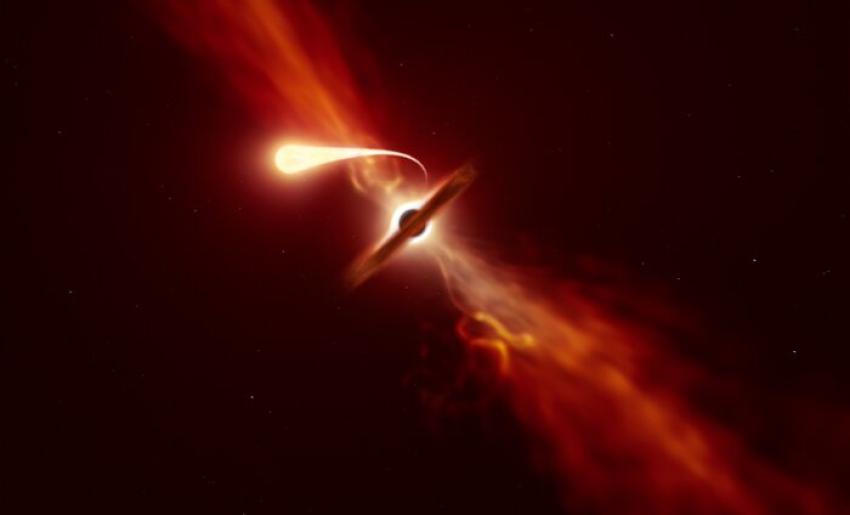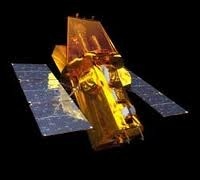From The Royal Astronomical Society (UK)
7.3.23
Media contacts
Ms Gurjeet Kahlon
Royal Astronomical Society
Mob: +44 (0)7802 877 700
press@ras.ac.uk
Ms Megan Eaves
Royal Astronomical Society
press@ras.ac.uk
Dr Robert Massey
Royal Astronomical Society
Mob: +44 (0)7802 877 699
press@ras.ac.uk
Science contacts
Dr Samantha Oates
University of Birmingham
s.r.oates@bham.ac.uk
Dr N. Paul M. Kuin
Mullard Space Science Laboratory, University College London
n.kuin@ucl.ac.uk
Dr Matt Nicholl
Queens University Belfast,
matt.nicholl@qub.ac.uk

This illustration depicts a star (in the foreground) experiencing spaghettification as its sucked in by a supermassive black hole (in the background) during a ‘tidal disruption event’. In a new study, done with the help of ESO’s Very Large Telescope and ESO’s New Technology Telescope, a team of astronomers found that when a black hole devours a star, it can launch a powerful blast of material outwards. Credit: M. Kornmesser/ESO. Licence type Attribution (CC BY 4.0)


A team of astronomers led by researchers from the University of Birmingham, University College London and Queen’s University Belfast have discovered one of the most dramatic ‘switches on’ of a black hole ever seen. They will present their findings on Tuesday 4 July at the 2023 National Astronomy Meeting in Cardiff. The work will also be published in MNRAS [below].
J221951-484240, known as J221951, is one of the most luminous transients – astrophysical objects that change their brightness over a short period of time – ever recorded. It was discovered by Dr Samantha Oates, an astronomer at the University of Birmingham, and her team, in September 2019 while searching for the electromagnetic light from a gravitational wave event. The team were using the Ultra-Violet and Optical Telescope on board the Neil Gehrels Swift Observatory to look for a kilonova, the sign of a neutron star merging with another neutron star or a black hole.

A kilonova typically appears blue, then fades and turns more red in colour over a timescale of days. What they found instead something even more unusual: J221951. The transient appeared blue, but didn’t change colour or fade rapidly as a kilonova would.
Multiple telescopes were used to follow-up J221951 and determine its nature, including NASA’s Swift/UVOT and Hubble Space Telescope, the South African Large Telescope, and ESO facilities such as the Very Large Telescope and the GROND instrument on the MPG/ESO 2.2-metre telescope at the La Silla Observatory.





A spectrum of J221951 taken with the Hubble Space Telescope ruled out the association of J221951 with the gravitational wave event. By examining the light spectrum of J221951, Dr Oates and her team were able to determine that the source is around 10 billion light years away, in contrast to the gravitational wave signal which was detected less than 0.5 billion light years away. The fact that it shines so brightly at such a large distance makes J221951 one of the most luminous transients ever detected.
Evidence suggests that J221951 came into existence as a result of a supermassive black hole feeding on surrounding material very rapidly. A red galaxy was observed at the location of J221951 prior to its detection, and the location of J221951 is consistent with the galaxy’s centre, where a massive black hole would naturally reside. It started to shine very suddenly – around 10 months prior to initial detection – meaning the black hole started feeding very quickly after being quiet for some time. The ultraviolet spectrum shows absorption features consistent with material pushed outwards by a huge release of energy. This, combined with its large luminosity, makes this one of the most dramatic ‘switches on’ of a black hole ever seen.
The team have identified two possible mechanisms that could explain this extreme feeding of a super massive black hole. The first is that it may have been caused by a tidal disruption event – the disruption of a star as it passes close to the supermassive black hole at the centre of its galaxy. The second is that it may have been produced by an active galactic nucleus ‘changing state’ from dormant to active. J221951 would then be the signal that a dormant black hole at the centre of the host galaxy has begun to feed on material from an accretion disk.
Dr Matt Nicholl, a member of the team from Queen’s University Belfast, said, “Our understanding of the different things that supermassive black holes can do has greatly expanded in recent years, with discoveries of stars being torn apart and accreting black holes with hugely variable luminosities.” He adds, “J221951 is one of the most extreme examples yet of a black hole taking us by surprise. Continued monitoring of J221951 to work out the total energy release might allow us to work out whether this is a tidal disruption of a star by a fast-spinning black hole, or a new kind of AGN switch on”.
Dr N. Paul Kuin, another member of the team from the Mullard Space Science Laboratory at University College London, said, “The key discovery was when the ultraviolet spectrum from Hubble ruled out a Galactic origin. This shows how important it is to maintain a space-based UV spectrograph capability for the future.”
Dr Samantha Oates adds, “In the future we will be able to obtain important clues that help distinguish between the tidal disruption event and active galactic nuclei scenarios. For instance, if J221951 is associated with an AGN turning on we may expect it to stop fading and to increase again in brightness, while if J221951 is a tidal disruption event we would expect it to continue to fade. We will need to continue to monitor J221951 over the next few months to years to capture its late-time behaviour.”
MNRAS
See the science paper for imagery not made otherwise available.
See the full article here .
Comments are invited and will be appreciated, especially if the reader finds any errors which I can correct. Use “Reply”.
five-ways-keep-your-child-safe-school-shootings
Please help promote STEM in your local schools.

The Royal Astronomical Society is a learned society and charity that encourages and promotes the study of astronomy, solar-system science, geophysics and closely related branches of science. Its headquarters are in Burlington House, on Piccadilly in London. The society has over 4,000 members (“Fellows”), most of them professional researchers or postgraduate students. Around a quarter of Fellows live outside the UK.
The society holds monthly scientific meetings in London, and the annual National Astronomy Meeting at varying locations in the British Isles. The Royal Astronomical Society publishes the scientific journals MNRAS and Geophysical Journal International, along with the trade magazine Astronomy & Geophysics.
The Royal Astronomical Society maintains an astronomy research library, engages in public outreach and advises the UK government on astronomy education. The society recognizes achievement in Astronomy and Geophysics by issuing annual awards and prizes, with its highest award being the Gold Medal of The Royal Astronomical Society. The Royal Astronomical Society is the UK adhering organization to the International Astronomical Union and a member of the UK Science Council.
The society was founded in 1820 as the Astronomical Society of London to support astronomical research. At that time, most members were ‘gentleman astronomers’ rather than professionals. It became the Royal Astronomical Society in 1831 on receiving a Royal Charter from William IV. A Supplemental Charter in 1915 opened up the fellowship to women.
One of the major activities of the RAS is publishing refereed journals. It publishes two primary research journals, the Monthly Notices of the Royal Astronomical Society [MNRAS] in astronomy and (in association with The German Geophysical Society [Deutsche Geophysikalische Gesellschaft e.V. ](DE)]) the Geophysical Journal International in geophysics. It also publishes the magazine A&G which includes reviews and other articles of wide scientific interest in a ‘glossy’ format. The full list of journals published (both currently and historically) by the RAS, with abbreviations as used for the NASA ADS bibliographic codes is:
Memoirs of the Royal Astronomical Society (MmRAS): 1822–1977[3]
Monthly Notices of the Royal Astronomical Society (MNRAS): Since 1827
Geophysical Supplement to Monthly Notices (MNRAS): 1922–1957
Geophysical Journal (GeoJ): 1958–1988
Geophysical Journal International (GeoJI): Since 1989 (volume numbering continues from GeoJ)
Quarterly Journal of the Royal Astronomical Society (QJRAS): 1960–1996
Astronomy & Geophysics (A&G): Since 1997 (volume numbering continues from QJRAS)
Associated groups
The RAS sponsors topical groups, many of them in interdisciplinary areas where the group is jointly sponsored by another learned society or professional body:
The Astrobiology Society of Britain (UK) (with The NASA Astrobiology Institute)
The Astroparticle Physics Group (with The Institute of Physics – London (UK))
The Astrophysical Chemistry Group (with The Royal Society of Chemistry)
The British Geophysical Association (with The Geological Society of London (UK).
The Magnetosphere Ionosphere and Solar-Terrestrial group (UK)
The UK Planetary Forum
The UK Solar Physics group

